It may be cold out but winter happens to be the best time of year to go out looking for ducks! In summer, our resident species go through their annual moult, causing them to appear duller than normal. But in winter, they will be in fresh breeding plumage and looking their best. It is also the best time to differentiate the males from the females, as they can look quite similar during the moult.
A guide to our wonderful winter waddlers
Guy Edwardes/2020VISION
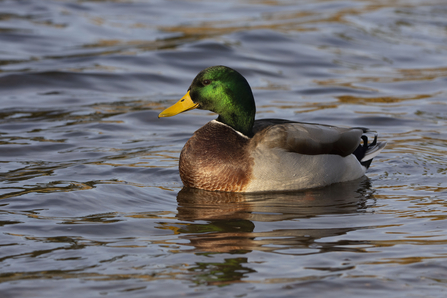
Alex Acott
Mallards are probably the most famous ducks due to how common they are. The males have resplendent green heads, and the females are comparatively dull. This trait is shared by many bird species and is known as sexual dimorphism. This is where the males and females of a species look different, sometimes to the point of seeming like entirely different species.
Females only select the brightest, most colourful of males as it is a good indicator of their fitness and therefore the best specimen to carry on their genes. It takes a lot of energy to maintain that plumage, so any illness will cause the quality to fade which makes them less attractive to females. Once more, bright colours make them more vulnerable to predators, so an individual being able to survive despite this must be very healthy indeed!
One interesting quality of mallards that is often overlooked is the shine of a male mallard’s green head. This is due to a quality known as iridescence, where the feathers contain microscopic structures that reflect light, air pockets to scatter light, and the melanin pigment to absorb light. This makes the feathers appear shiny and even change colour depending on the direction of the light. I find it fascinating how the females’ selection process has led to these impressive colours!
The other iridescent part of a mallard is what is known as the speculum, which both genders share. The speculum is an area of the secondary feathers on the wing, which is purple in mallards. This is a key identification point to help separate female mallards from a similar species, the gadwall, which have a white speculum.
It is believed that the speculum evolved to signal between other ducks in the air during flocking. Gadwalls of both sexes are camouflaged amongst the reeds, which would be particularly important during nesting. The white speculum would give it away, but it is largely hidden by the rest of the wing when on the ground. They only show during flight. As the wings contract and extend, the speculum has an obvious blinking effect, much like waving a flag around. Ducks often flock together, so this may have evolved to enable them to differentiate between other birds and stick with their own species.
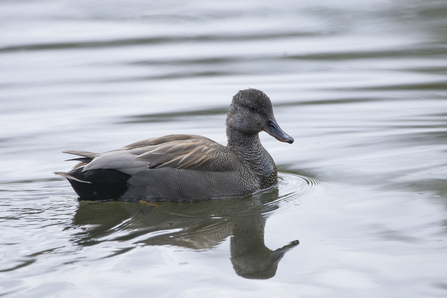
Alex Acott
In winter, our resident ducks are joined by many new species! This is because many species of waterfowl spend their summers in the north such as in Scandinavia but travel south in winter where it is warmer and typically easier to find food.
One such winter visitor is the pintail. On their way here, they flock together and create the iconic V formation. This reduces drag for the birds at the back thereby costing them less energy. This does require the bird in front put in more work, but the flock take turns at going at the front, so the effort is evenly distributed.
Pintails are dabbling ducks which mean they primarily feed along the surface of the water. They have long necks and can reach into deeper water by tipping their bodies head-down and pointing their tails straight up to reach the vegetation and aquatic insects.
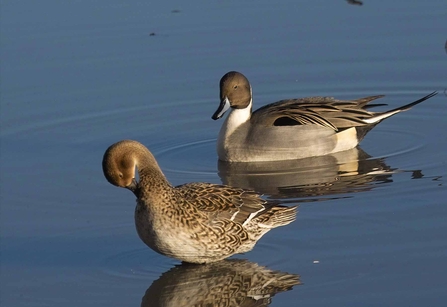
Derek Moore
The pintail is joined by many other species of winter ducks, and these tend to have different feeding strategies to prevent competition even if they occupy similar habitats. For instance, the teal is also a dabbling duck, but they spend their time in more shallow water hoovering up vegetable matter and invertebrates close to the surface. They are our smallest duck so you can imagine they might be quite vulnerable to predators at the water’s edge. But because they are so light, they can take off vertically to escape quickly and are very manoeuvrable in flight.
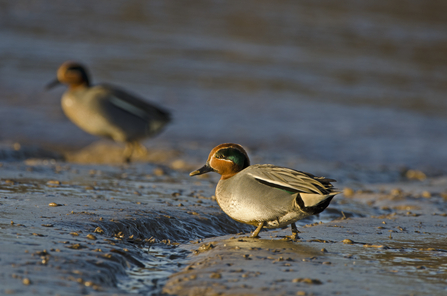
David Tipling/2020VISION
Shovelers in contrast are our largest dabbler and have huge unmistakable bills that they sweep along the water to filter it for small invertebrates and seeds. Their bill is wide to cover a greater surface area and increase the likelihood of securing food.
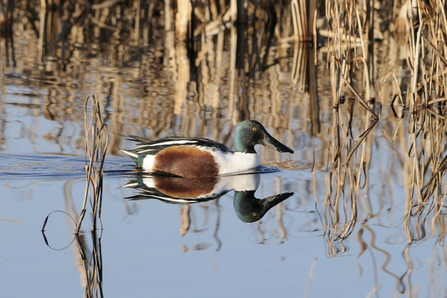
Nick Upton/2020VISION/naturepl.com
The wigeon is another dabbler but they are exclusively vegetarian. They paddle along the water’s edge or in wet grassland, using their stubby beaks to eat seeds and crop grass. They do not have bacteria in their gut to help digest cellulose so instead they ingest small amounts of grit to help them break down the cell walls of plant matter in their gizzards.
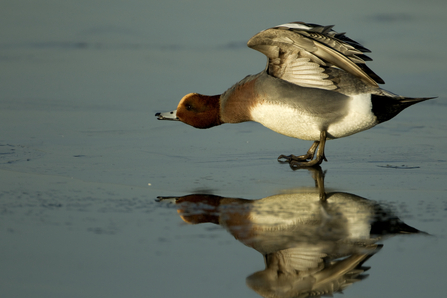
Danny Green/2020VISION
Not all ducks are dabblers. Some dive for their prey such as the pochard and tufted duck. They go underwater in search of snails, small fish, and aquatic insects. Diving allows them to reach deeper than dabblers, but this uses up a lot more energy. This is partly due to duck feathers being coated in a water-resistant oil, which keeps them dry and buoyant – even when underwater. This is a wonderful adaptation that has led ducks to become so successful but can work against them whilst diving as they must fight their buoyancy. Think of trying to swim underwater with a life jacket on.
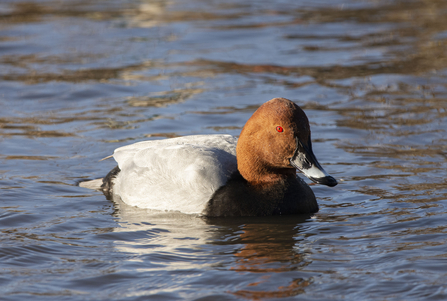
Alex Acott
There is a group of ducks known as sawbills that manages to actively chase down fish underwater despite this. They have their feet set far back on the body to help increase speed and aerodynamics. The drawback of this makes them quite clumsy on land, so you usually only see them in the water except when they nest.
Birds do not have teeth, having lost them to reduce weight to enable them to fly more easily. Instead, they have lightweight beaks, but sawbills have developed a serrated edge giving them a toothy appearance. This is to grab a hold on their slippery fish prey. The sawbills we have in the UK are goosanders, red breasted merganser and the smew – all of which are winter visitors to Essex and quite uncommon.
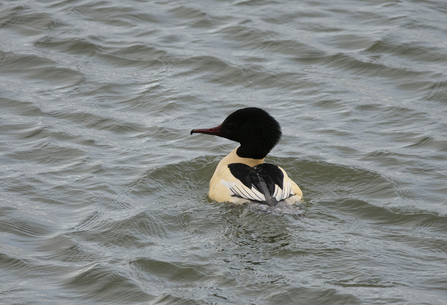
Alex Acott
It may be warmer here than where they originate, but they still must contend with chilly weather. Have you ever wondered how they manage to stand on a sheet of ice without freezing their feet? Especially as the increased surface area of their webbed feet leads them to being more exposed to the cold. They have an amazing adaptation called counter-current heat exchange. This is where the arterial blood travelling to the feet is cooled by the venous blood travelling back to the heart and vice versa. This ensures very little heat loss despite the exposure.
You can find all these duck species in Essex and witness all these incredible behaviours yourself. Among the best places are Hanningfield Reservoir and Abberton Reservoir – huge water bodies with several bird hides so you can witness thousands of water birds without causing disturbance. There are many ducks that I haven’t covered here, and these sites sometimes attract rarities! Tips as to their identification can be found inside the hides or a handy guide on waterfowl can be found below.
Alex Acott
Campaigns Volunteer

